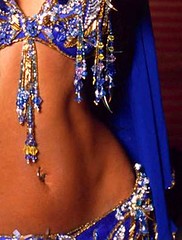 As a teacher of the method of Pilates, it is my main form of exercise. I love the strength, flexibility and endurance I have gain from my study of Pilates. Yet, like most of us, I do not rely on it solely for my complete physical conditioning. I enjoy a Bikram yoga class as much as Doug does. I dedicated 6 mos to strength training with SuperSlow. Rather than grit-your -teeth gym or running regimens, I gravitate towards movement and dance: Andalusi dance, and NIA are great experiential workouts. I am coming to adore Belly Dancing, taught in San Antonio by Karen Barbee.
As a teacher of the method of Pilates, it is my main form of exercise. I love the strength, flexibility and endurance I have gain from my study of Pilates. Yet, like most of us, I do not rely on it solely for my complete physical conditioning. I enjoy a Bikram yoga class as much as Doug does. I dedicated 6 mos to strength training with SuperSlow. Rather than grit-your -teeth gym or running regimens, I gravitate towards movement and dance: Andalusi dance, and NIA are great experiential workouts. I am coming to adore Belly Dancing, taught in San Antonio by Karen Barbee.The Middle Eastern dance form has come along way since being introduced to westerners through the Orientalist artists and exhibitions at the world's fair. Martha Graham, mother of Modern D
 ance, was initiated into dance by dance pioneer Ruth St. Denis, who interpreted the dance of the orientals in ballet. Today, pop singers Aaliyah and Shakira have introduced forms of belly dancing to the masses. Chances are every community has a belly dance teacher in their area or a restaurant featuring belly dancers as evening entertainment.
ance, was initiated into dance by dance pioneer Ruth St. Denis, who interpreted the dance of the orientals in ballet. Today, pop singers Aaliyah and Shakira have introduced forms of belly dancing to the masses. Chances are every community has a belly dance teacher in their area or a restaurant featuring belly dancers as evening entertainment.Belly Dancing is an ancient ethnic folk dance form. Where belly dancing is native, men and women perform the dance at typical social gatherings such as wedding and night clubs. The origins are debated. There is evidence that it was part of the childbirthing process. The belly dancing we have come to know is the more theatrical version, rather than the simple style of dance performed by today's Arabs.
The term "kootchy-kootchy", which I thought was a euphemism for girly parts, was actually the nickname given to the "little egypt" dancers of the burlesque halls. It refers to the shimmy and shake.

Unlike ballet, where a plie is a plie whether it is taught in Paris, France or Paris, Texas, belly dancing is very stylized. The style of dance one may come across may be influenced by India, Turkey, North Africa, Greece or even Southern Spain. Two contemporary styles include "tribal fusion" and "gothic belly dancing".
The basic movements of the belly dance are hip sways, hip circles, hip slides, rib slides, rib or chest circles, shimmies and snake arms. The accompanying music lends itself to the sensual and erotic techniques employed by the belly dancer.
Pilate
 s is a marriage of the body, mind and spirit. I find belly dancing to be also. The belly dance is a vigorous, cardio workout. It emphasizes the torso, due to the abdominal undulations. I can attest to the incredible workout. There is isolation of muscles or muscle groups. Dancers can expect to tone their "core", and the arms and pelvis get their share of toning. It burns about 300 calories, similar to those of a light jog or riding a bike.
s is a marriage of the body, mind and spirit. I find belly dancing to be also. The belly dance is a vigorous, cardio workout. It emphasizes the torso, due to the abdominal undulations. I can attest to the incredible workout. There is isolation of muscles or muscle groups. Dancers can expect to tone their "core", and the arms and pelvis get their share of toning. It burns about 300 calories, similar to those of a light jog or riding a bike.Besides being a great workout, the flowing, expressive movements are sure to inspire more frequent and creative romantic liaisons.
 The accessories are fun, too! A triangular hip scarf with 2 or 3 rows can be purchased for about $25. I throw mine over my favorite Lululemon Athletica Reverse Groove pants. They can also be wrapped to make a halter top for going out on the town.
The accessories are fun, too! A triangular hip scarf with 2 or 3 rows can be purchased for about $25. I throw mine over my favorite Lululemon Athletica Reverse Groove pants. They can also be wrapped to make a halter top for going out on the town.The basic skills of belly dancing are easy to catch on to. Hips go front to back, side to side. Ribs go right, back, left and front. Arms up, down. Put it all together with some cool Arabia-esque rhythms and you are belly dancing. A quick google search will tell you that you don't have to be rail thin or under thirty to be a belly dancing enthusiast. While dancing off a few pounds, new seduction skills are learned, perhaps earning us more gold from our sultan!

No comments:
Post a Comment